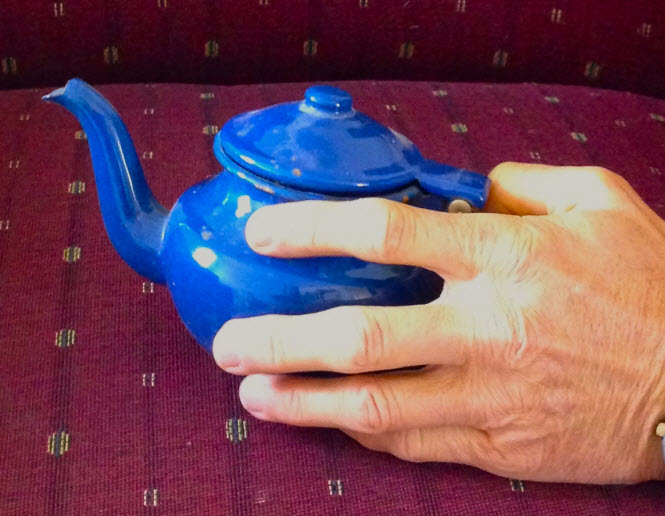 by Robb Davis
by Robb Davis
I remember the first time I really started thinking about water. Despite growing up in the riparian beauty of the Pennsylvania piedmont where water ubiquitously ran through open fields, I had never really thought about it as a source of life. A trip into the edge of the western Sahara-over the stricken landscape of Mauritania-changed that. It came on the tail end of a decade-long drought in in the mid-1980s and was occasioned by a proposed health intervention that required us to assess the nutritional status of children in villages along a band of dying oases out on the fringes of the sand and rock. This trip made me really think about water for the first time.
Local guides led us through shifting dunes to arrive in exhausted ancient salt-trade-route towns to weigh kids whose lives were draining away in the sand. I say “draining away” literally because many suffered from dehydration brought on by chronic diarrhea and misguided feeding practices that indicated that food and drink should be withheld from children suffering from diarrhea.
As a 20-something soon to be father, I was not prepared for what I saw: little bodies literally shriveled to nothing due to a lack of the most basic ingredient of life. Many died of malnutrition. Others of shock induced by severe dehydration. Seeing anything so stark will make one think about water.
On that same trip we arrived in the hometown of a local nurse who was traveling with us and he excitedly told us about some improvements to his home-including a new “shower room” he had installed. He encouraged us all to use it when evening came and I, for one, was excited to finally be able to wash the dust of a three-day trip off my skin. When my turn came he ushered me (with some ceremony) into a room made of packed earth. A candle burned on a holder (no electricity out here); a simple drain was built into the floor; a clean, if small, towel hung on a peg and, in the middle of the floor sat a teapot no larger than my hand containing the water for my shower.
Though I had no idea how to do it then, I learned over time how to scrub the essential areas with a pittance of water while leaving the non-essential ones covered in a fine layer of dust that made my mien indistinguishable from my traveling mates. A shower in a land of no water is a fine luxury indeed.
In that land I traveled to towns that contained hand dug wells over 150 feet deep. Some of these had dried up, collapsed on themselves, or been spoiled when an errant calf fell into them. In most places these wells represented the sole source of water for the populace and whole villages ceased to exist due to their loss. In one out of the way place at the end of a desert track of sand (we used to say of such places: “this may not be the end of the world, but you can see it from here) we found a town in which the well had collapsed but the villagers had found a small cleft in a rock with a spring some 50 feet down. The only problem was, the cleft was only large enough for a soup-can-sized receptacle to be lowered into the water. And so the villagers took turns day and night dipping the can, pulling it back up and repeating the process to meet the basic water needs there. Water for survival…
And at the end of the dry season-called locally the season of “ends that can’t be joined” (the time when last year’s grain simply will no longer stretch to meet the harvest of the new crop), I drank tea made of camel’s milk which was more plentiful than water as the dromedary yielded up the last of what she had stored in her hump; a hump that would slouch over until the rains came again and its replenishment could take place. Tea made of salty camel’s milk-one can acquire a taste for that.
In those days-and for many years after-I hardly ever stopped thinking about water: how to live with a limited supply, how to harness the little that falls to grow crops or replenish underground aquifers, how to encourage moms not to withhold it-but actually give more-when a child has diarrhea.
Whatever becomes of Davis’ water project I am glad that this campaign has made us think and talk together about this resource that we all too often take for granted. No, we do not live on the desert’s edge and we will not “run out”. No, we will not have to make the tradeoff between drinking and bathing ourselves.
But it seems that we could spend more time thinking about water as the precious thing it is rather than as a commodity for which we simply need to get the price right. A basic human need should never be commodified because our use of it should never be without deep consideration. Water is part of our “commons” and we should manage it together with care.
As an early morning runner I see first hand our disregard for this singular source of life. I see many gallons used for what appears to be the end of watering our concrete sidewalks and asphalt paths. I see many more gallons poured with apparent abandon on over-watered and stressed trees. And I far too frequently cross greenbelts soggy with chronic overwatering. I see my own wastefulness of running the water until the warm stuff from the other end of the house reaches the faucet in my bathroom.
I have now lived long enough to see armed conflict over water. In this state it is at the heart of many of our most troubling public conflicts-and has been for generations. With populations increasing and periodic droughts a certainty here (as they always have been), the conflict is only set to increase around water. If we cannot move the debate away from our “rights” to use it in any damn way we please, in any amount we desire (but always at an affordable cost, of course), we will not be well prepared to deal with the real conflicts that lie before us.
So, I just want us to think about water. About water as a source of life. About water as a resource for a sustainable community. About water as a precious thing we can care for so that its availability remains reliable to our children’s, children’s children.
My time on the desert’s edge made me mindful of the beauty and dearness of water and I don’t ever want to forget that.





Soon to be more expensive to water the sidewalks and streets, to have lush, deep green lawns, and to shower to our hearts’ content. Incentives!
Robb, your post just about made me cry, for I am a believer in every precious drop, even though sometimes I forget for a moment. Incentives many need, indeed. I really can’t say how I got this way, because I have never taken a trip to the edge of the desert or seen this reality, but I could feel it for as long as I can now remember. Certainly my mother taught us not to waste things, but it resonated with me beyond her teaching somehow.
dlemongello: You’ve asked on a couple of threads about the possibility of a 50% reduction in water usage by conservation. Those threads are dropping down the board, so I thought I’d reply here.
That would be a very severe reduction in landscape irrigation. We know what it would take. In Marin County in the 1970’s they had to impose a 57% cut in water usage for the critically low-water winter of 1976-7. It required mandatory conservation, complete with fines and the threat of criminal sanctions. Landscapes were, at that level of cutback, very adversely affected, and that is in an area with a much lower evapotranspiration rate than we have here.
You can get 10 – 20% reduction in water usage by education and outreach. You can achieve more by means of incentive-based tiered water structure, but just look at the howls of outrage at the relatively mild tiered structure that’s before the voters right now. 50% would require coercive measures.
And it really seems unnecessary to me, when we have a massive river flowing by twenty miles away. Water is not, in fact, a scarce commodity here. Water is quite abundant most of the time. It is a matter of using it in a manner that doesn’t adversely affect downstream users (of which we have few, as it happens). And of providing the plumbing. In the ‘first’ world, water supply and capacity is a function of engineering and technology.
There are hundreds of water districts in California, and they differ in the extent to which they have planned for our Mediterranean climate (those that are part of that; Eureka isn’t exactly the same as Los Angeles…). Just look at Contra Costa County compared to Solano County, two counties side by side. The former has about a two year buffer against drought due to small reservoirs and limited water rights. Solano County can get through six years of low rainfall because of Lake Berryessa.
In California, water supply is about planning and infrastructure. Practically nowhere in the state do the residents live solely on the annual rainfall or the storage of nearby reservoirs, as is largely the case in developing countries.
Robb: thoughtful article; thanks.
You mentioned seeing all that potable water pouring all over sidewalks and streets.
Since the City has not been charging Parks and Rec for that water, the department has zero financial incentive to reduce the waste. Same for all city departments. That’s one reason why, as a practical thing, it is important that the City follow Prop 218, and charge its internal departments for their water useage. You had better believe city departments are now going to watch their consumption!
In many third world tropical countries they use rain water powering a little hamster-wheel gizmo to charge cell phones before the water goes into catch basins for household use.
Don – Thanks for laying out these points. I just want to be clear that I am NOT recommending we live like Mauritanians (and laying on a thick layer of guilt was not my point either). We have been talking about water intensively for a year now and I just wanted to challenge us to not stop thinking about it and consider ways to use it more responsibly. There is much we can do and you lay out what some of the parameters are.
As for the relative scarcity of water here, you are definitely correct that our storage and management options are key to liberating us from the year to year risks I experienced in West Africa. However, and I know you know this, that storage and management infrastructure comes at a cost and it must be maintained (I could have just as easily talked about the elaborate earthen irrigation systems I saw in Northern Afghanistan that had failed due to lack of repair). My point is, maintaining a safe and secure water supply takes the same level of attention (and respect for the precarious nature of its supply) here as it does in a place where it is truly scarce.
Prior to late 1800s conversion to ag land, it’s my understanding that much of the Davis area was a wetlands; with some areas getting dry near end of summer; but annual ET likely close to what it is now with current landscaping vegetation. The Davis area is not a desert area; it is a mediteranean climate with a dry season of several months.
That said; given the realities of inexorable population growth; I agree with proposals above for reduction of water waste and increased water use efficiency; but would object to severe restrictions on water use for landscaping.
Don–your comments seem sensibly moderate to me; given your knowledge of plants and trees; would you recommend that the city make a move to gradually re-plant city properties (parks, greenbelts, etc.)with vegetation that requires somewhat less water; when replanting is needed according to regular schedules? I don’t mean cactus and rock gardens; perhaps just vegetation with deeper roots that need less water during summer dry season? With proper education; residents and private property owners could gradually follow suit on their own private properties.
jimt: Yes, and that would be very easy to do over a period of time. They could even make a more intensive move toward lower-water landscaping: reducing turf areas, replacing them with ‘meadow’ grass plantings and lower-water ground covers, gradually replacing irrigation timers with ‘smart’ timers, and so on. The parks and rec folks know how to do this, but they might find it helpful to have direction from the city council in the form of overall conservation directives, and possibly input from a technical advisory committee.
Don and jimt, I guess we just need to ask the CC to start making these landscaping/water use changes then, but there will probably be others against it. Gotta start somewhere though, I guess I just get stuck thinking “they must already know”. Thanks for the constructive posts. I finally figured out that ET is evapotransporation, agreed we have a slightly drier than, but Med climate.
Yes, now that the city has been called to account for city water usage; looks like in future will have financial incentive in future to conserve water in operation of parks, greenbelts, etc.. I just hope we don’t veer from one extreme (some careless water use and some outright water waste thru over-irrigation and runoff to pavement) to the opposite extreme (dry and dusty public parks and greenbelts; with scant greenery). I vote for moderation!
Robb Davis, Beautiful and well written. I also lament the wasted water on the greenbelts & people’s sidewalks. So unnecessary.